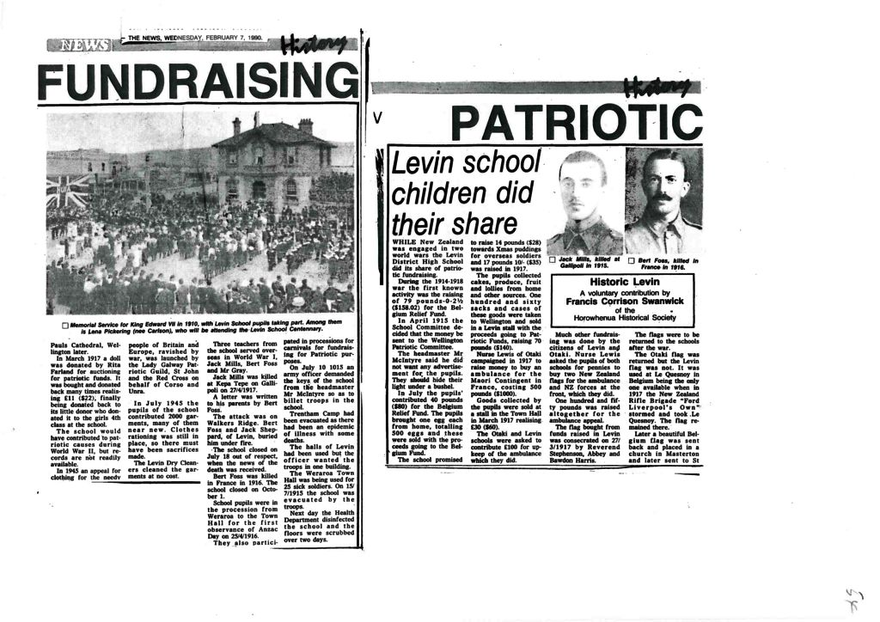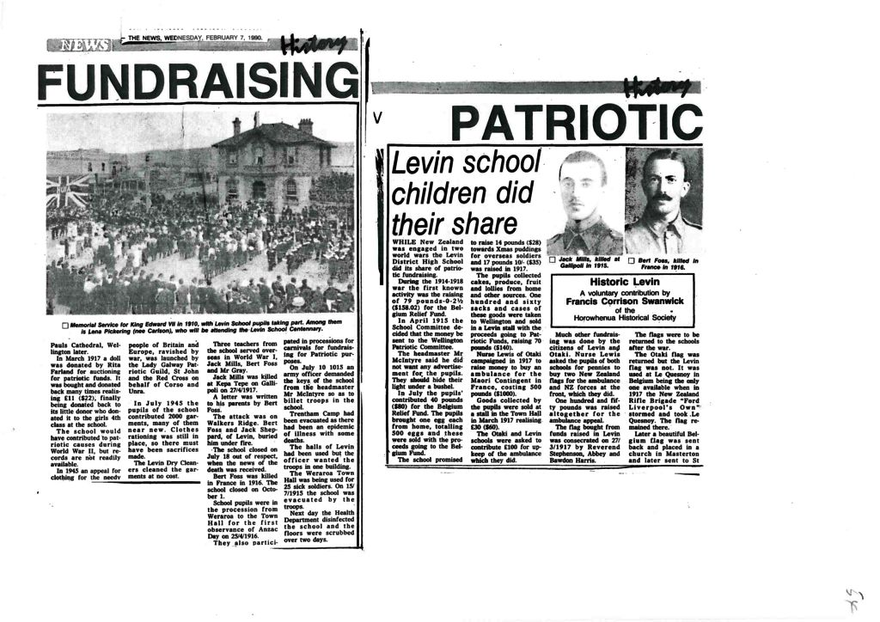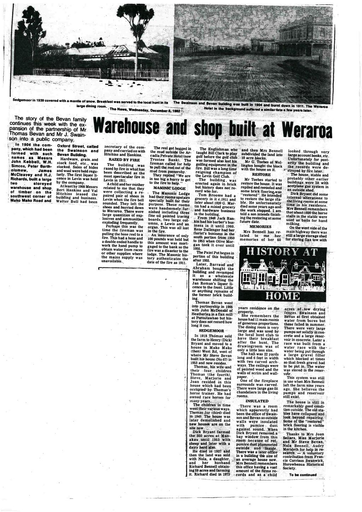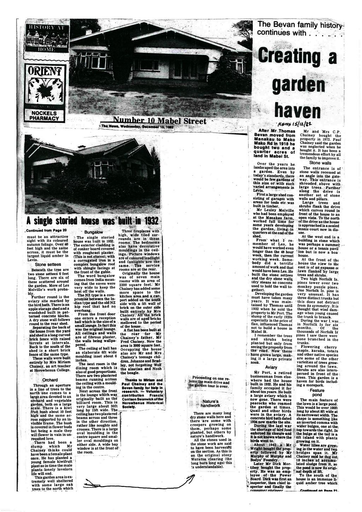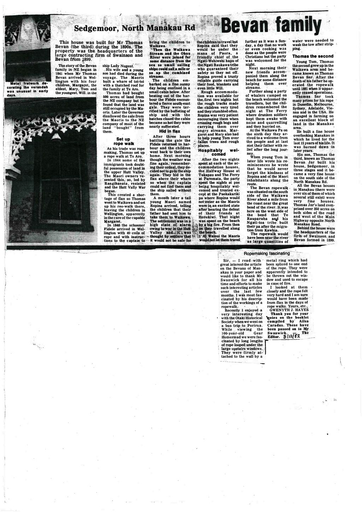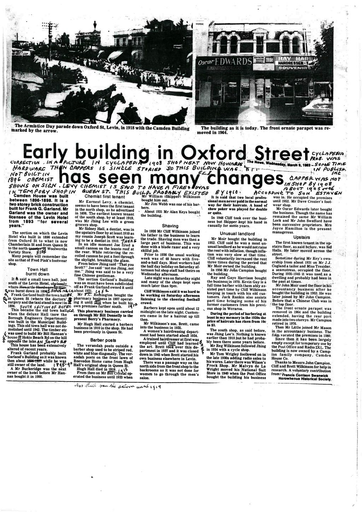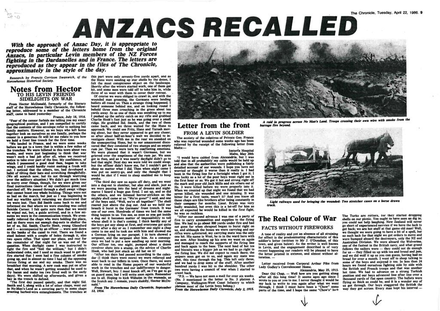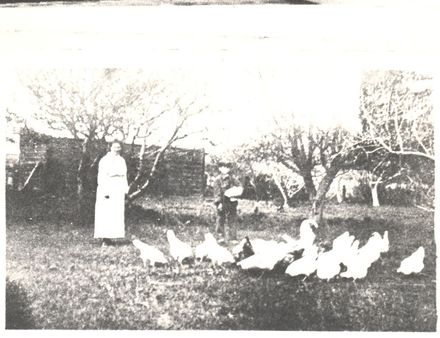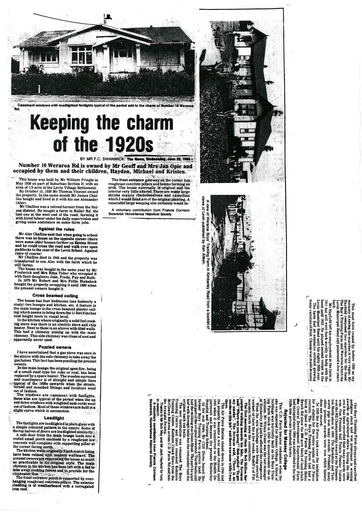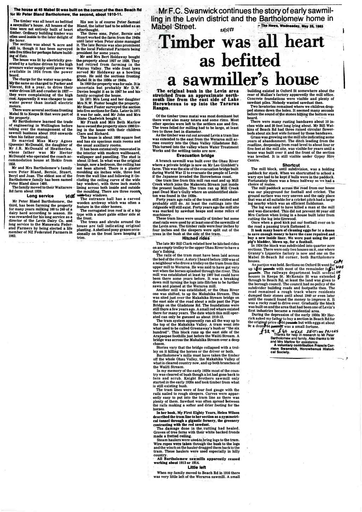Patriotic Fundraising
- Description
 Photo at left shows Memorial Service for King Edward VII in 1910, with Levin School pupils taking part. Among them is Lena Pickering (nee Carlson), who will be attending the Levin School Centenary.
Photo at left shows Memorial Service for King Edward VII in 1910, with Levin School pupils taking part. Among them is Lena Pickering (nee Carlson), who will be attending the Levin School Centenary.
During the 1914-1918 war the first known activity was the raising of 79 pounds -0-2 ½ ($158.02) for the Belgium Relief Fund.
In April 1915 the School Committee decided that the money be sent to the Wellington Patriotic Committee.
The headmaster Mr McIntyre said he did not want any advertisement for the pupils. They should hide their light under a bushel.
In July the pupils’ contributed 40 pounds ($80) for the Belgium Relief Fund. The pupils brought one egg each from home, totalling 500 eggs and these were sold with the proceeds going to the Belgium Fund.
The school promised to raise 14 pounds ($28) towards Xmas puddings for overseas soldiers and 17 pounds 10/- ($35) was raised in 1917. The pupils collected cakes, produce, fruit and lollies from home and other sources. One hundred and sixty sacks and cases of these goods were taken to Wellington and sold in a Levin stall with the proceeds going to Patriotic Funds, raising 70 pounds ($140).
Nurse Lewis of Otaki campaigned in 1917 to raise money to buy an ambulance for the Maori Contingent in France, costing 500 pounds ($1000).
Goods collected by the pupils were sold at a stall in the Town Hall in March 1917 realising £30 ($60).
The Otaki and Levin schools were asked to contribute £100 for upkeep of the ambulance which they did.
Much other fundraising was done by the citizens of Levin and Otaki. Nurse Lewis asked the pupils of both schools for pennies to buy two New Zealand flags for the ambulance and NZ forces at the front, which they did.
One hundred and fifty pounds was raised altogether for the ambulance appeal.
The flag bought from funds raised in Levin was consecrated on 27/3/1917 by Reverend Stephenson, Abbey and Bawdon Harris. The flags were to be returned to the schools after the war.
The Otaki flag was returned but the Levin flag was not. It was used at Le Quesnoy in Belgium being the only one available when in 1917 the New Zealand Rifle Brigade “Ford Liverpool’s Own” stormed and took Le Quesnoy. The flag remained there.
Later a beautiful Belgium flag was sent back and placed in a church in Masterton and later sent to St Pauls Cathedral, Wellington.
In March 1917 a doll was donated by Rita Farland for auctioning for patriotic funds. It was bought and donated back many times realising £11 ($22), finally being donated back to its little donor who donated it to the girls 4th class at the school. The school would have contributed to patriotic causes during World War II, but records are not readily available.
In 1945 an appeal for clothing for the needy people of Britain and Europe, ravished by war, was launched by the Lady Galway Patriotic Guild, St John and the Red Cross on behalf of Corso and Unra.
In July 1945 the pupils of the school contributed 2000 garments, many of them near new. Clothes rationing was still in place, so there must have been sacrifices made. The Levin Dry Cleaners cleaned the garments at no cost.
Three teachers from the school served overseas in World War I, Jack Mills (shown in photo below left), Bert Foss (shown in photo below right) and Mr Gray.
Jack Mills was killed at Kepa Tepe on Gallipoli on 27/4/1917. A letter was written to his parents by Bert Foss. The attack was on Walkers Ridge. Bert Foss and Jack Sheppard, of Levin, buried him under fire.
The school closed on July 18 out of respect, when the news of the death was received.
Bert Foss was killed in France in 1916. The school closed on October 1.
School pupils were in the procession from Weraroa to the Town Hall for the first observance of Anzac Day on 25/4/1916.
They also participated in processions for carnivals for fundraising for Patriotic purposes.
On July 10 1915 an army officer demanded the keys of the school from the headmaster Mr McIntyre so as to billet troops in the school. Trentham Camp had been evacuated as there had been an epidemic of illness with some deaths. The halls of Levin had been used but the officer wanted the troops in one building.
The Weraroa Town Hall was being used for 25 sick soldiers. On 15/7/1915 the school was evacuated by the troops. Next day the Health Department disinfected the school and the floors were scrubbed over two days.
THE NEWS, WEDNESDAY, FEBRUARY 7, 1990
Identification
- Date
- February 7, 1990
Taxonomy
- Community Tags

